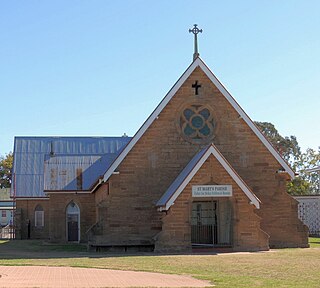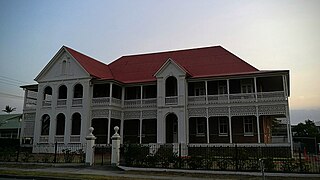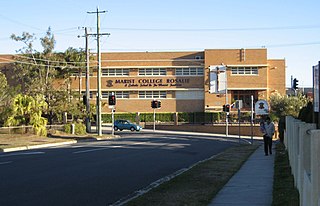
The Holy Name Cathedral was a planned but never-built Roman Catholic cathedral for the city of Brisbane, Queensland, Australia. Designed by Hennessy, Hennessy & Co, initially in an English Baroque style inspired by St Paul's in London, it was intended to have been the largest church building of any Christian denomination in the Southern Hemisphere. James Duhig, the Archbishop of Brisbane, was the chief proponent of the project.

St Brigid's Church is a heritage-listed Roman Catholic church located at 78 Musgrave Road, Red Hill, City of Brisbane, Queensland, Australia. It was designed by Robin Dods and built from 1912 to 1914 by Thomas Keenan. It was added to the Queensland Heritage Register on 21 October 1992.

The First St Mary's Roman Catholic Church is a heritage-listed sandstone Roman Catholic former church building at 163 Palmerin Street, Warwick, Southern Downs Region, Queensland, Australia. It was designed by Benjamin Joseph Backhouse and built from 1863 to 1865 by CA Doran. It is also known as St Mary of the Assumption Church and St Mary's Church. It was added to the Queensland Heritage Register on 21 October 1992.

The second St Mary's Roman Catholic Church is a heritage-listed sandstone Catholic church at 163 Palmerin Street in Warwick in the Southern Downs Region, Queensland, Australia. It was designed by Dornbusch & Connolly and built from 1920 to 1926. It is also known as St Mary of the Assumption Church. It was added to the Queensland Heritage Register on 21 October 1992.

St Mary's Church is a heritage-listed Roman Catholic church at 271–275 Adelaide Street, Maryborough, Fraser Coast Region, Queensland, Australia, on land donated to the Church by Maryborough pioneer James Cleary. It was initially designed by Charles Tiffin with later additions and alterations by Francis Drummond Greville Stanley and POE Hawkes. The initial construction was from 1869 to 1872 by G Smith and J Thomas. It was added to the Queensland Heritage Register on 21 October 1992.

St James Church is a heritage-listed Anglican church at 145 Mort Street, Toowoomba, Queensland, Australia. It was designed by Richard George Suter and built from 1869 to 1953. It is also known as St James Church of England. It was added to the Queensland Heritage Register on 28 July 2000.

St Patrick's Cathedral is a heritage-listed Roman Catholic cathedral on James Street, South Toowoomba, Toowoomba, Toowoomba Region, Queensland, Australia. It was designed by Toowoomba architect James Marks and was built from 1883 to 1935. The site of the cathedral was originally a church and school known as St Patrick's Church School. In 1899, the school was moved to make way for the building of the cathedral and in 1959 renamed as St Saviour's School. St Patrick's Cathedral was added to the Queensland Heritage Register on 21 October 1992.

The Church of Saint Ignatius Loyola is a heritage-listed Roman Catholic church at 46 Grove Street, Toowong, City of Brisbane, Queensland, Australia. It was designed by architect Jack Hennessy, junior, and built from 1929 to 1936 by Concrete Construction (QLD) Limited. It was added to the Queensland Heritage Register on 12 July 2005.

John Francis (Jack) Hennessy (1887–1955) was an Australian architect, with the same name as his architect father, John Francis Hennessy, with whom he was in partnership as Hennessy & Hennessy from 1912 to 1924. As principal of the firm after his father retired from 1924 to 1955, he was responsible for many major Art Deco office buildings in capital cities in Australia and New Zealand in the 1930s, as well as many projects for the Catholic Church in Queensland, and the Great Court of the University of Queensland.

St Mary's Church is a heritage-listed Roman Catholic church at 20 Merivale Street, South Brisbane, Queensland, Australia. It was designed by Simkin and Ibler and built from 1892 to 1929. It was added to the Queensland Heritage Register on 3 December 2004.

Our Lady of Victories Church is a heritage-listed Roman Catholic war memorial church at 29 Cintra Road, Bowen Hills, City of Brisbane, Queensland, Australia. It was designed by Hall & Prentice and built from 1919 to 1962. It is also known as White Temple of Peace. It was added to the Queensland Heritage Register on 11 November 1996.

Mount Carmel Convent is a heritage-listed Roman Catholic former convent at 199 Bay Terrace, Wynnum, City of Brisbane, Queensland, Australia. It was designed by Hall & Dods and built in 1915 by William Richard Juster. It was added to the Queensland Heritage Register on 27 August 1999.

Nazareth House is a heritage-listed benevolent institution at 272 Wynnum North Road, Wynnum, City of Brisbane, Queensland, Australia. It was built from 1924 to 1939. It was added to the Queensland Heritage Register on 2 April 2002.

Villa Maria Hostel is a heritage-listed nursing home at 167–173 Saint Paul's Terrace, Fortitude Valley, City of Brisbane, Queensland, Australia. It was designed by Frank Cullen, Hennessy, Hennessy, Keesing & Co, & J P Donoghue and built from 1927 to 1968. It was added to the Queensland Heritage Register on 18 September 2008.
Hennessy & Hennessy was an architectural firm established in 1912 in Sydney, Australia that was responsible for a series of large scale office buildings in the 1930s in all capital cities in Australia, as well as New Zealand and South Africa, designed by John (Jack) Hennessy (1887–1955), described as Australia's first international architect.

St Josephs Cathedral is a heritage-listed Roman Catholic cathedral at 170 William Street, Allenstown, Rockhampton, Rockhampton Region, Queensland, Australia. It was designed by Francis Drummond Greville Stanley and built from 1893 to 1982. It was added to the Queensland Heritage Register on 21 October 1992. The cathedral serves as the seat for the Bishop of Rockhampton.

St Patrick's Church is a heritage-listed Roman Catholic church at Church Street, Gympie, Gympie Region, Queensland, Australia. It was designed by Francis Drummond Greville Stanley and built from 1883 to 1935. It was added to the Queensland Heritage Register on 20 February 1995.

The Range Convent and High School is a heritage-listed private school at 263 Agnes Street, The Range, Rockhampton, Rockhampton Region, Queensland, Australia. It was built from c.1880s to 1930s. It is also known as Our Lady of Good Counsel Convent and School and The Catholic College Residential. It was added to the Queensland Heritage Register on 21 October 1992.

Marist Brothers College Rosalie Buildings are heritage-listed Roman Catholic monastery and school buildings at Fernberg Road, Rosalie, City of Brisbane, Queensland, Australia. They are also known as Marist Brothers' Monastery and Marist College. They were added to the Queensland Heritage Register on 18 September 2008.

Mary Immaculate Church is a heritage-listed Roman Catholic church located on the corner of Ipswich Road and Ferndale Street, Annerley, a suburb of Brisbane, Queensland, Australia. Mary Immaculate Church is located in the Archdiocese of Brisbane and is under the care of the Brisbane Oratory in Formation, a Congregation of the Oratory of St. Philip Neri.






















